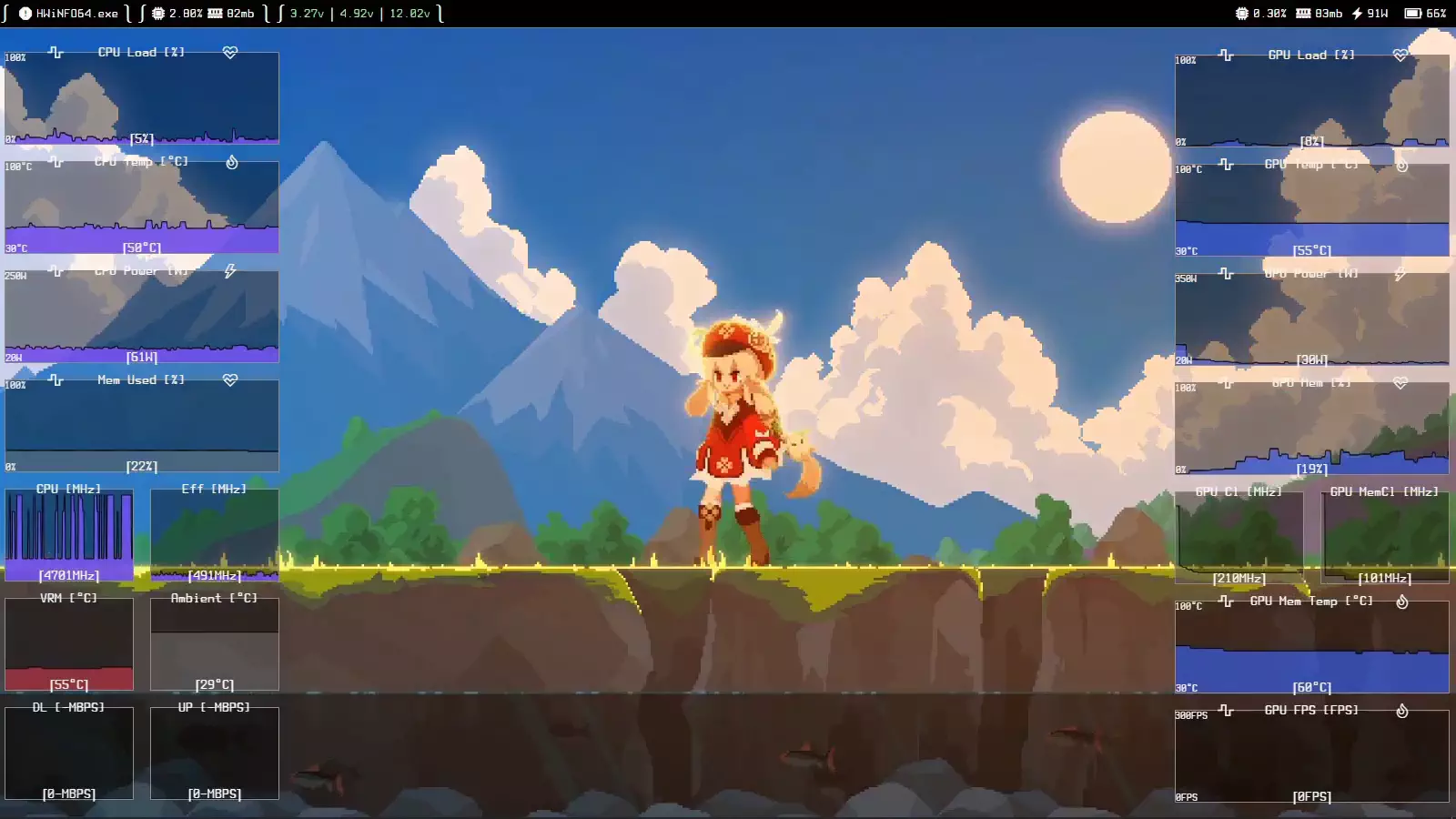HWHash 1.4.0
dotnet add package HWHash --version 1.4.0
NuGet\Install-Package HWHash -Version 1.4.0
<PackageReference Include="HWHash" Version="1.4.0" />
<PackageVersion Include="HWHash" Version="1.4.0" />
<PackageReference Include="HWHash" />
paket add HWHash --version 1.4.0
#r "nuget: HWHash, 1.4.0"
#addin nuget:?package=HWHash&version=1.4.0
#tool nuget:?package=HWHash&version=1.4.0
HWHash
HWHash Collects HWiNFO's sensor information in realtime, via shared memory and writes them directly to a easily accessible Dictionary.
A tiny, singleton (static) class that reads HWiNFO Shared Memory and packs it to a Dictionary.
- 🦄 Single file static class with no external dependencies.
- 😲 Tiny footprint, no memory leaks and 0.01% CPU Usage.
- 💨Blazing fast, <1millisecond to iterate over 300 sensors.
- ✨It simply works.
Features
- Unique ID for each sensor avoid name collision
- Compatible with all HWiNFO versions with Shared Memory Support
- Collects "Parent Sensor" information such as Name, ID and Instance
- Hashes both the Sensor's Original name and the User Defined name
- Exports sensor information in the same order HWiNFO UI
- Exports to a List or JSON string in both Full and Minified versions *check the minified struct version below.
Installation
Nuget package is available:
NuGet\Install-Package HWHash
Usage
It is as simple as:
HWHash.Launch();
Options
There are three startup options for HWHash.
| Option | Default |
|---|---|
| HighPrecision |  |
| HighPriority |  |
| Delay |  |
How to configure
Make sure you set the parameters before Lauching the HWHash thread.
High Precision:
HWHash.HighPrecision = true;
High Priority:
HWHash.HighPriority = true;
Delay:
//update the Dictionary every 500ms (twice per second)
HWHash.SetDelay(500);
Then → Launch()
HWHash.HighPrecision = true;
HWHash.HighPriority = true;
HWHash.SetDelay(500);
HWHash.Launch();
Basic Functions
//Returns a List<HWINFO_HASH> in the same order as HWiNFO UI
List<HWiNFO_HASH> MyHWHashList = HWHash.GetOrderedList();
//Same as above but in a minified version
List<HWINFO_HASH_MINI> MyHWHashListMini = HWHash.GetOrderedListMini();
JSON Functions
//Returns a JSON string containing all sensors information (full/mini)
string _HWHashJson = HWHash.GetJsonString();
string _HWHashJsonMini = HWHash.GetJsonStringMini();
//If set to true, it will return a ordered list*
string _HWHashJsonOrdered = HWHash.GetJsonString(true);
//Same for the minified version
string _HWHashJsonMiniOrdered = HWHash.GetJsonStringMini(true);
Default Struct
This is the base struct, it contains all HWiNFO sensor data, such as min, max and avg values.
public record struct HWINFO_HASH
{
public string ReadingType { get; set; }
public uint SensorIndex { get; set; }
public uint SensorID { get; set; }
public ulong UniqueID { get; set; }
public string NameDefault { get; set; }
public string NameCustom { get; set; }
public string Unit { get; set; }
public double ValueNow { get; set; }
public double ValueMin { get; set; }
public double ValueMax { get; set; }
public double ValueAvg { get; set; }
public string ParentNameDefault { get; set; }
public string ParentNameCustom { get; set; }
public uint ParentID { get; set; }
public uint ParentInstance { get; set; }
public ulong ParentUniqueID { get; set; }
public int IndexOrder { get; set; }
}
Minified Struct
The minified version is more suitable for 'realtime' monitoring, since it is packed in a much smaller package.
public record struct HWINFO_HASH_MINI
{
public ulong UniqueID { get; set; }
public string NameCustom { get; set; }
public string Unit { get; set; }
public double ValueNow { get; set; }
[JsonIgnore(Condition = JsonIgnoreCondition.Always)]
public int IndexOrder { get; set; }
}
Relevant Sensor List
If you prefer to avoid manually searching for sensor IDs and wish to access a curated List<HWINFO_HASH> of relevant sensors directly, use this function.
public static List<string> RelevantSensorsList { get; } = new List<string>
{
"Physical Memory Load",
"Physical Memory Used",
"P-core 0 VID",
"P-core 0 Clock",
"Ring/LLC Clock",
"Total CPU Usage",
"CPU Package",
"Core Max",
"CPU Package Power",
"Vcore",
"+12V",
"SPD Hub Temperature",
"GPU Temperature",
"GPU Memory Junction Temperature",
"GPU 8-pin #1 Input Voltage",
"GPU 8-pin #2 Input Voltage",
"GPU 8-pin #3 Input Voltage",
"GPU Power (Total)",
"GPU Core Load",
"GPU Memory Controller Load",
"Current DL rate",
"Current UP rate",
"Total Errors"
};
PowerShell Integration
In case you want to invoke HWHash from PowerShell, it is possible to do so, follow the steps below:
- Ensure you have PowerShell 7.0 or newer [Here]
- Download the latest release of HWHash DLL [Here]
- Create a test script with the code below
#Don't forget to change the line below
$Path = "A:\GITHUB\HWHash\bin\Debug\net6.0\HWHash.dll"
$ClassName = "HWHash"
$MethodLaunch = "Launch"
$MethodJsonStringMini = "GetJsonStringMini"
Add-Type -Path $Path
$Type = [System.Reflection.Assembly]::LoadFrom($Path).GetTypes() | Where-Object { $_.Name -eq $ClassName }
if ($Type -ne $null) {
$Instance = [Activator]::CreateInstance($Type)
$Type.GetMethod($MethodLaunch).Invoke($Instance, $null)
function Get-JsonStringMini {
param (
[bool]$Order = $false
)
$result = $Type.GetMethod($MethodJsonStringMini).Invoke($Instance, @($Order))
Write-Host $result
}
Get-JsonStringMini -Order $true
} else {
Write-Host "Type '$ClassName' not found in the assembly."
}
Result:

Performance
You can access HWHash performance metrics by invoking the following method:
HWHashStats _Stats = HWHash.GetHWHashStats();
HWHashStats struct
public record struct HWHashStats
{
public long CollectionTime { get; set; }
public uint TotalCategories { get; set; }
public uint TotalEntries { get; set; }
}
The most critical information we want to inspect is
...
long ProfilingTime = _Stats.CollectionTime;
...
On a decent modern system, even if there are over 300 sensors, profiling times should stay <1 millisecond. Which is not a concern since HWiNFO will flush new data with a minimum delay of 100ms between readings.
CollectionTime returns the time in milliseconds between each full loop, in the screenshot above, there are 359 distinct sensor readings.
We know that for Overclockers and Hardware enthusiasts, it is important to have fast, reliable and accurate readings, and a 1 millisecond overhead is well within what is considered a safe margin.
Notes on Sensor Poll Rate
This library relies on a third party application, which is HWiNFO, and HWiNFO relies on the exposed sensors from your hardware, such as motherboard sensors, CPU, GPU sensors, etc.
Usually sensor access/read is deadly fast (nanoseconds) and it is never a bottleneck. There are few rare examples, for instance, on my personal system I am currently using Corsair Vengeance memory sticks, and each memory stick has a temperature sensor, out of 359 different readings on my system, the DIMMs are the only ones who take more than nanoseconds to be read, in my case, HWiNFO takes around 6MS to poll the Memory Temperature from all chips.
Since HWiNFO fastest "poll rate" is 50MS, it is not a problem, but it is definitely something that we should keep an eye on when reading from sensors exposed by our hardware.
Usecase
CruelMonitor was built using HWHash as its 'data provider.' CruelMonitor uses C# backend data source, it also serves as a WebSockets server to share the content in realtime, messages packed with MessagePack and are delivered with minimal delays.
Performance metrics are drawed directly on the Windows Desktop, 60FPS, <1ms delay and low CPU usage.

To-do
Lacking 👀
- Smoothing/interpolation for values
- Add the option to Flush to InfluxDB
- Option to create triggers/alerts
- Save presets and sensor preferences
- Visual interface to select/deselect sensors
Added 💖
- JSON export with no third party libraries
- Add Min, Max, Average
- Store previous reading value
- PowerShell Integration
License
This project is licensed under GLWTPL
| Product | Versions Compatible and additional computed target framework versions. |
|---|---|
| .NET | net9.0 is compatible. net9.0-android was computed. net9.0-browser was computed. net9.0-ios was computed. net9.0-maccatalyst was computed. net9.0-macos was computed. net9.0-tvos was computed. net9.0-windows was computed. |
-
net9.0
- No dependencies.
NuGet packages
This package is not used by any NuGet packages.
GitHub repositories
This package is not used by any popular GitHub repositories.


